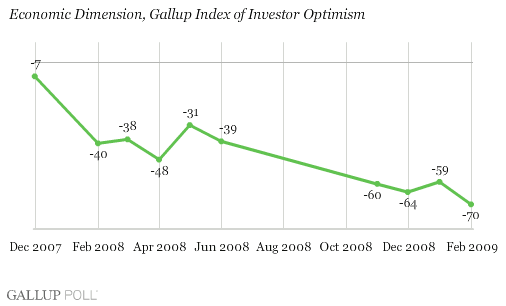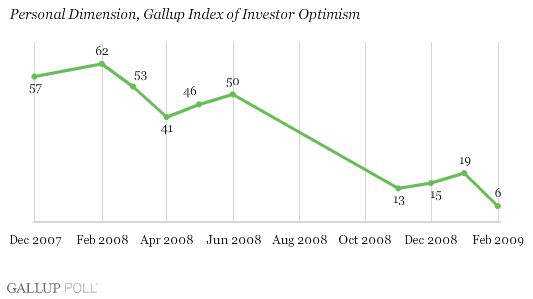PRINCETON, NJ -- American investor optimism plunged in February, as the Gallup Index of Investor Optimism -- a broad measure of investor perceptions -- fell 24 points to -64, a new low.

New Low in Investor Optimism
Neither the president's signing of the new fiscal stimulus bill last Tuesday nor his announcement of a new housing rescue plan on Wednesday was able to keep Gallup's Index of Investor Optimism -- a survey of those having $10,000 or more of investable assets -- from plunging to its lowest level since its inception in October 1996.
The Index peaked at 178 in January 2000, just prior to the bursting of the dot-com bubble. Last year, the Index turned negative for the first time in its history, reaching its previous low of -49 in December. Before last year, the low for the Index was 5 in March 2003, reflecting investor concerns at the outset of the Iraq war.
Optimism deteriorated along both dimensions of the Index in February. Investor expectations for the U.S. economy over the next 12 months became even more negative, as the Economic Dimension of the Index worsened by 11 points to -70 -- worse than December's -64 and a new low. At the same time, investors' expectations for their personal portfolios worsened by 13 points to 6 -- a new low for the Personal Dimension.


Average Investor Perceptions -- Not Just the Stock Market -- Plunged Last Week
On Friday, the Dow Jones Industrial Average fell to its lowest level since October 2002, and, as of midday Monday, it was moving even lower. Much more importantly, average investor optimism -- a much broader measure of investor perceptions than the stock market averages because it is not heavily influenced by either the nation's largest investors or Wall Street traders -- also dropped, but to an all-time low. Accordingly, it is not only the wealthy, but the one-third or more of Americans with some investable assets who have lost confidence in the future direction of the economy over the past couple of weeks.
Given the passage of record new fiscal spending legislation and the announcement of a major new effort to address the nation's foreclosure problem, a boost in confidence would seem to be a reasonable expectation. However, this does not appear to be the case for consumer confidence, according to Gallup's Daily measurement of consumer mood, or for the average investor.
In part, this less-than-enthusiastic response to the new Obama administration's efforts to fix the economy may stem from a lack of clarity about how either effort is going to stimulate the economy or create jobs in the immediate term. The tepid response might also be owing to the continued rapid deterioration of the jobs market and the fear it is generating, concerns about the rapidly growing budget deficit, and feelings of "unfairness" as reflected by some of the objections about who is included and who is excluded from the housing foreclosure rescue plan.
Still, the greatest source of deterioration in investor perceptions may be owing to the instinctive recognition on both Wall Street and Main Street of something one might call "government risk." This started under the Bush administration, as the Treasury and the Fed responded on an ad hoc basis to the growing financial crisis, and has intensified under the Obama administration. As the government intervenes on an ever-greater scale to help ameliorate the economic crisis, it is changing the rules of the game by which the private-sector economy usually operates. This has the side-effect of creating new government risk for consumers, investors, and businesses alike.
The current banking situation with its talk of nationalization is a prime example. Basically, the government has announced that it will apply new "stress tests" to the nation's banks and then use these tests to decide which banks will remain in business and which banks will essentially be taken over by the federal government. Regardless of whether this is a good idea, when it is suggested without details, it may have the unintended effect of increasing the degree of government risk associated with every banking institution. In turn, a virtual run on bank stocks can occur as investors flee a risk they cannot evaluate. In this way, the perception of surging government risk can do far more to destroy investor confidence than efforts like the stimulus bill can do to rebuild it.
Government needs to act quickly and forcibly to stabilize the financial system -- once and for all -- and to get credit flowing again. As it does so in banking and elsewhere, however, it should act to minimize the degree of government risk it creates and the unintended consequences it produces.
Survey Methods
Gallup Poll Daily interviewing includes no fewer than 1,000 U.S. adults nationwide each day during 2008. The Index of Investor Optimism results are based on questions asked of 1,000 or more investors over a three-day period each month, conducted Feb. 17-19 and Jan. 16-18, 2009, and Dec. 16-18, Nov. 24-26, June 3-6, April 25-28, March 28-31, and Feb. 28-March 2, 2008. For results based on these samples, the maximum margin of sampling error is ±3 percentage points.
Results for May are based on a Gallup Panel study and are based on telephone interviews with 576 national adults, aged 18 and older, conducted May 19-21, 2008. Gallup Panel members are recruited through random selection methods. The panel is weighted so that it is demographically representative of the U.S. adult population. For results based on this sample, one can say with 95% confidence that the maximum margin of sampling error is ±5 percentage points.
For investor results prior to 2008, telephone interviews were conducted with at least 800 investors, aged 18 and older, and having at least $10,000 of investable assets. For the total sample of investors in these surveys, one can say with 95% confidence that the maximum margin of sampling error is ±4 percentage points.
Interviews are conducted with respondents on land-line telephones (for respondents with a land-line telephone) and cellular phones (for respondents who are cell-phone only).
In addition to sampling error, question wording and practical difficulties in conducting surveys can introduce error or bias into the findings of public opinion polls.
